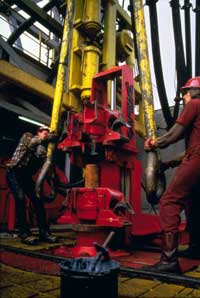Scientists Discover Effects from Rapid, Global Climate and Ocean Changes of the Past

The National Science Foundation supports the Ocean Drilling Program. Using equipment like the drill pictured here, workers obtain geologic samples from the deep seafloor that provide scientists with new information on Earth’s history. Examples of information documented by these samples include a history of the ocean basins and evidence of drastically changing climates on earth, including more ice ages than were previously known. <br>Photo Credit: Texas A&M University <br>
An international team of marine geologists has just completed an expedition to an area off the coast of Surinam known as the Demerara Rise. The scientists were part of the two-month Leg 207 of the NSF-supported Ocean Drilling Program (ODP) expedition in the equatorial Atlantic Ocean. The project studied periods in Earth’s history that have undergone rapid climate and ocean circulation changes and likely led to mass extinctions of plants and animals.
Three decades ago, geologists found sediments in the Demerara Rise from the Cretaceous Period (140-65 million years ago) that contained evidence of times when the equatorial Atlantic Ocean was without oxygen. These periods, known as “ocean anoxic events,” indicate that the oceans had a vastly different circulation pattern than they do today.
“Therefore, climate would have been significantly different. We don’t yet fully understand the reasons for these differences,” said Jochen Erbacher of the Federal Institute for Geosciences and Natural Resources in Germany. “Our objective [on this cruise] was to re-core the former site to understand past ocean circulation with respect to water depth change.”
Scientists also brought up sediment cores that show other periods of dramatic change in Earth’s history. In these sediments are well-preserved intervals of the Cretaceous/Tertiary boundary. At that time, some 65 million years ago, a huge asteroid or comet crashed into the Earth. Scientists believe the resulting cloud of debris may have blocked out sunlight, resulting in the extinction of plants and animals, including dinosaurs.
The Leg 207 team included sedimentologists, stratigraphers, paleontologists, geochemists, engineers, and geophysicists.
“It is only through the integration of all these disciplines that we can begin to understand the causes and effects of these periods of climatic and oceanographic change,” said scientist David Mosher of the Geological Survey of Canada. “With a better understanding of what happened in the past, we can perhaps know more about what the Earth is presently enduring,” he said.
Adds Paul Dauphin, program director for ODP at NSF, “The research team chose this area for the potentially high-resolution paleoceanographic records that could be recovered [in sediments] for the time intervals of interest, and for the important role that tropical regions play in driving ocean and atmospheric circulation.”
ODP is an international partnership of scientists and research institutions organized to study the evolution and structure of the Earth. It is funded principally by NSF, with substantial contributions from international partners.
Media Contact
All latest news from the category: Earth Sciences
Earth Sciences (also referred to as Geosciences), which deals with basic issues surrounding our planet, plays a vital role in the area of energy and raw materials supply.
Earth Sciences comprises subjects such as geology, geography, geological informatics, paleontology, mineralogy, petrography, crystallography, geophysics, geodesy, glaciology, cartography, photogrammetry, meteorology and seismology, early-warning systems, earthquake research and polar research.
Newest articles

First-of-its-kind study uses remote sensing to monitor plastic debris in rivers and lakes
Remote sensing creates a cost-effective solution to monitoring plastic pollution. A first-of-its-kind study from researchers at the University of Minnesota Twin Cities shows how remote sensing can help monitor and…

Laser-based artificial neuron mimics nerve cell functions at lightning speed
With a processing speed a billion times faster than nature, chip-based laser neuron could help advance AI tasks such as pattern recognition and sequence prediction. Researchers have developed a laser-based…

Optimising the processing of plastic waste
Just one look in the yellow bin reveals a colourful jumble of different types of plastic. However, the purer and more uniform plastic waste is, the easier it is to…



